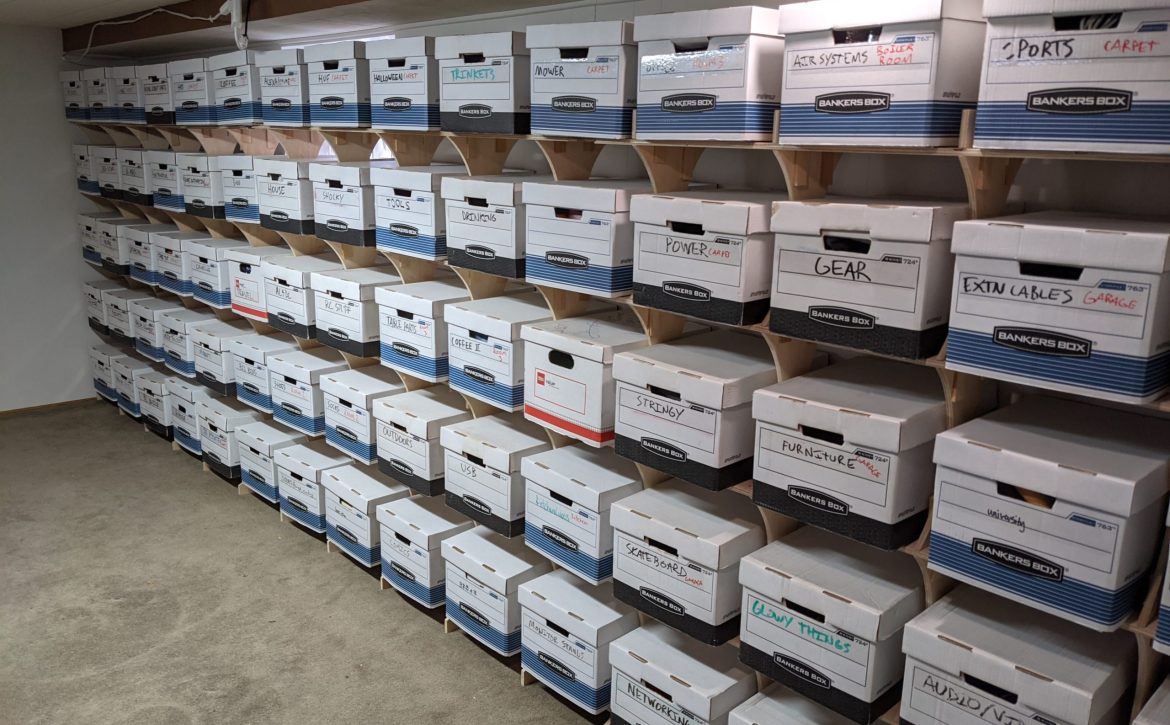Banker box physical storage vs. Scanned document cloud storage
This is one of those comparisons that you have to dig pretty deep into to see the real pros and cons of each scenario.
On average it costs about $4.82 to handle a single paper document. If you think about all the paper documents you store within your business and need to retrieve on a daily basis, those numbers start to add up fast.
As banker boxes start adding up, the need to do something with them becomes apparent.
Most paper documents live 30 to 90 days dispersed between mail room, physical department inbox, peoples desks, and filing cabinets before they are put into bankers boxes for long term storage. These bankers boxes are either stacked and stored somewhere at the company’s property or they are shipped to a facility that specializes in physical paper document storage.
Another scenario is that existing bankers boxes are sent to a scanning service bureau, of which could also be a facility that specializes in physical paper document storage, to be prepped, scanned, indexed and uploaded to a secure cloud storage repository or on premise document imaging application. These documents are considered a “backfile conversion”. Newly received documents are typically prepped, scanned, indexed and uploaded to the same secure cloud or on premise storage repository on a daily basis but by company’s staff unless the volumes are too large. These documents are considered “day forward conversion”.
Now this is how the documents wind up in their respective long term spaces but what are the differences of both scenarios and what about retrieval?
Storing banker boxes on site:
The number one reason why organizations deal in a paper only environment is resistance to change. If it’s not broken, why fix it? Unfortunately this is what happens when the real understanding of the costs and inefficiencies is hiding in the shadows.
If documents are not scanned and before the documents are archived, we are dealing with paper documents that can only be in one place at one time and only retrieved by one person unless there are copies made. When working with paper documents, collaboration is extremely difficult. One of the biggest drawbacks of paper-based document management systems is the associated costs. You will need more printers and photocopiers, filing cabinets, and other office supplies including banker boxes. These costs add up and can become a significant expense. One of the biggest information security risks for businesses is paper because printed documents can be easily lost, mishandled or damaged. Paper documents can take up a significant amount of space, and the quantity of paper will increase day by day. There is also the very real threat of disaster of which there is no means of recovery.
Storing banker boxes off site:
Iron Mountain is considered to be one of the largest document storage facilities in the US with over 1,500 storage facilities. They are highly regarded in this industry. We will use Iron Mountain as our example.
The following information was gathered from the Iron Mountain website:
With Iron Mountain, it costs $139 to store from 1 to 80 boxes per month. It costs $67 to retrieve one box that you pick up. If in the course of one year, you store up to 80 boxes and need to retrieve documents from 10 boxes per month, there would be a cost of $670 per month or $8,040 per year to manage these documents. If you need 25 documents per month that costs rises to $16,750 per year.
If you store 1 to 80 more boxes the next year, your storage costs double and will continue to do so until you can start purging older documents. There is another cost to destroy the boxes at $889 to shred 55-100 boxes.
These documents will not be instantly accessible to get to the right person and you still need to search through the bankers box to find the right document once you get to it.
So the moral of this story is that if you almost never need a document once it’s stored, this could be the most economical way to store your documents.
Using a digital repository for your scanned documents.
Information access is the key to process improvement – the ability to search and retrieve documents in seconds, not hours or days, the ability to share or comment on the documents digitally, or respond immediately to an internal or external customer information request. These process productivity and customer response improvements can deliver far more ROI than simply comparing the cost of storage to the cost of conversion, and they provide the long-term benefits of information access.
According to an Association for Intelligent Information Management (AIIM) survey, The biggest driver for scanning and data capture is improved searchability and shareability (53%). Higher productivity, reduced storage space and faster response are all key drivers.
Information access is the key to process improvement – the ability to search and retrieve documents in seconds, not hours or days, the ability to share or comment on the documents digitally, or respond immediately to an internal or external customer information request. These process productivity and customer response improvements can deliver far more ROI than simply comparing the cost of storage to the cost of conversion, and they provide the long-term benefits of information access.
According to an AIIM survey, The biggest driver for scanning and data capture is improved searchability and shareability (53%). Higher productivity, reduced storage space and faster response are all key drivers.
Per the Iron Mountain website (https://www.ironmountain.com/), if you want to store your documents in their cloud storage, It costs $500 to prepare documents for scanning, scan, and index four fields per document / per bankers box. There is also a $150 per month online storage space for up to and every 250 bankers boxes.
Per the ScanSearch website (https://www.ScanSearch.com), it costs $325 to prepare documents for scanning, scan, and full text index per bankers box. ScanSearch utilizes full text OCR to index documents.
Index or utilize full text OCR for scanned documents
Full-text OCR (Optical Character Recognition) and field indexing are two different approaches to extracting information from scanned documents. Each method has its advantages, and the choice between them depends on the specific requirements of the document management or information retrieval system. Here are some benefits of full-text OCR compared to field indexing:
- Comprehensive Information Extraction:
- Full-Text Content: Full-text OCR extracts and makes searchable the entire text content of a document, capturing all words and characters. This allows for comprehensive information retrieval, especially when the content is relevant across the entire document.
- Flexibility in Search Queries:
- Unrestricted Search Queries: Users can perform flexible and unrestricted search queries across the entire text of documents. This flexibility is particularly beneficial when users are uncertain about the specific field or metadata to search for.
- No Predefined Fields Required:
- Dynamic Document Types: Full-text OCR doesn’t require predefined fields or structured data. It is suitable for documents with varying formats, layouts, or structures, making it adaptable to different types of content.
- Minimizes Manual Data Entry:
- Automation: Full-text OCR minimizes the need for manual data entry since it automatically extracts and indexes the textual content of documents. This reduces the potential for human errors and speeds up the indexing process.
- Time and Cost Efficiency:
- Quick Implementation: Implementing full-text OCR can be quicker and more cost-effective, especially when dealing with large volumes of documents. It eliminates the need for extensive manual indexing efforts.
- Effective for Document Discovery:
- Discovery of Relevant Content: Full-text OCR is effective for discovering relevant content within documents, making it suitable for applications where the goal is to find information across various document types without prior knowledge of specific fields.
- Applicability to Content Analysis:
- Content Mining: Full-text OCR enables content mining and analysis, allowing organizations to gain insights from large datasets by identifying patterns, trends, or keywords within the textual content.
The time it takes to index a scanned document can vary widely based on several factors. Here are key considerations that can influence the time required for document indexing:
- Document Complexity:
- Simple vs. Complex Documents: The complexity of the document significantly impacts indexing time. Simple, well-structured documents may be indexed more quickly than complex documents with varied layouts, tables, and graphics.
- Document Length:
- Short vs. Long Documents: The length of the document matters. Indexing a short document may be a quick process, while longer documents, especially those with multiple pages, may take more time.
- Volume of Documents:
- Single vs. Bulk Indexing: The time required is influenced by the volume of documents. Indexing a single document will take less time compared to bulk indexing, where many documents need to be processed simultaneously.
- Quality of Scanned Images:
- Clear vs. Poor-Quality Scans: The quality of the scanned images affects OCR accuracy. Clear, high-resolution scans with legible text are processed more quickly, while poor-quality scans may require additional processing time and manual verification.
- OCR Technology and Automation:
- Automation vs. Manual Indexing: The use of advanced OCR technology and automation tools can significantly reduce indexing time. Automated extraction of text and metadata speeds up the process compared to manual data entry.
- Complexity of Metadata Extraction:
- Simple vs. Detailed Metadata: Extracting simple metadata (e.g., dates, titles) may be faster than extracting detailed or complex metadata. The level of detail required in the indexing process influences the time investment.
- System Performance:
- Processing Speed: The speed and performance of the hardware and software used for indexing play a role. High-performance systems can process documents more quickly than slower systems.
- Human Involvement:
- Automation vs. Manual Verification: The level of human involvement affects indexing time. Fully automated processes may be faster, but some applications may require manual verification to ensure accuracy.
- Indexing Methodology:
- Full-Text OCR vs. Field Indexing: The choice between full-text OCR and field indexing influences the time required. Full-text OCR processes the entire document content, while field indexing focuses on specific metadata.
- Preprocessing Steps:
- Document Preparation: Any preprocessing steps, such as document preparation, cropping, or enhancing image quality, can add to the overall time required for indexing.
It’s important to note that advancements in OCR technology and automation tools have significantly reduced indexing times for many applications. However, the specific requirements of the indexing task, the characteristics of the documents, and the chosen technology or tools all contribute to the overall time investment. Organizations should assess their specific needs and workflows to determine the most efficient indexing approach for their context.
- OCR Technology and Automation:
- Automated vs. Manual Data Entry: The use of Optical Character Recognition (OCR) technology and automated data extraction tools can significantly speed up the process compared to manual data entry. Automated tools can extract text and populate fields more quickly.
- Quality of Scanned Images:
- Clear vs. Poor-Quality Scans: High-quality, clear scans with legible text facilitate faster data entry. Poor-quality scans may require additional time for manual verification and correction.
- Volume of Data:
- Amount of Data to Enter: The total volume of data to be entered directly impacts the time required. Entering a small amount of data will be quicker than entering large volumes of information.
- Accuracy Requirements:
- Accuracy vs. Speed: The level of accuracy required in data entry can affect the speed of the process. Balancing accuracy and speed is essential to avoid errors that may require later correction.
- Human Involvement:
- Manual Verification: Even with automated tools, some applications may require manual verification to ensure accuracy. The extent of human involvement in the verification process influences the overall time investment.
- Data Validation and Quality Control:
- Validation Processes: Implementing data validation and quality control measures may add time to the data entry process, but it ensures the accuracy and reliability of the entered data.
- Experience and Training:
- Data Entry Operator Skills: The experience and training of the data entry operators play a role. Skilled operators familiar with the document types and data formats can work more efficiently.
- Document Preparation:
- Preprocessing Steps: Any preprocessing steps, such as document preparation, sorting, or organization, can impact the overall time required for data entry.
- Integration with Automated Systems:
- System Integration: Integration with automated systems or data entry software can streamline the process, reducing manual effort and accelerating data entry.
- Efficiency of Tools and Software:
- Efficiency of Data Entry Tools: The efficiency and user-friendliness of the tools and software used for data entry contribute to overall speed and productivity.The Association for Information and Image Management (AIIM), after completing two surveys on the costs and benefits of paper-based and paperless solutions, said that the majority of the organizations they surveyed (84%) had achieved a payback, or total return on investment (ROI) from a paperless office software project in less than 18 months. 59% got all of their money back in less than 12 months; 26% achieved ROI in six months or less.
Storing scanned documents online, as opposed to using physical storage services like Iron Mountain, offers several benefits. Here are some advantages of online document storage:
- Accessibility:
- Anywhere, Anytime Access: Online storage allows users to access documents from any location with an internet connection. This is especially beneficial for businesses with remote or distributed teams.
- Multiple Devices: Documents can be accessed and viewed on various devices, such as computers, tablets, and smartphones.
- Cost Efficiency:
- Reduced Physical Storage Costs: Online storage eliminates the need for physical space, filing cabinets, and off-site storage services, potentially reducing costs associated with physical storage facilities.
- Lower Overhead: Digital storage reduces administrative overhead related to managing physical documents, such as transportation and handling costs.
- Search and Retrieval:
- Efficient Search: Online storage platforms often provide robust search functionalities, making it easy to locate specific documents quickly through keywords, metadata, or other search criteria.
- Version Control: Digital storage systems often include versioning capabilities, allowing users to track changes and revert to previous versions if needed.
- Security:
- Encryption: Many online storage solutions implement encryption measures to secure data, protecting it from unauthorized access.
- Access Control: Online storage platforms often offer granular access controls, allowing administrators to restrict access to sensitive documents based on user roles and permissions.
- Disaster Recovery:
- Data Backups: Online storage solutions typically include automated backup processes, ensuring data integrity and providing a means for disaster recovery.
- Redundancy: Data redundancy measures can be implemented to safeguard against data loss due to hardware failures or other unexpected events.
- Collaboration:
- Real-time Collaboration: Online storage facilitates real-time collaboration among team members, allowing multiple users to work on and edit documents simultaneously.
- Version History: Version tracking helps teams keep tabs on document changes, making collaboration more transparent and accountable.
- Environmental Impact:
- Reduced Paper Usage: Shifting to online storage reduces the need for printing and storing physical documents, contributing to environmental sustainability.
- Scalability:
- Easier Expansion: Online storage solutions can be more easily scaled to accommodate growing data volumes compared to physical storage systems.
While these benefits highlight the advantages of online document storage, it’s essential to consider specific business needs, security requirements, and compliance standards when choosing a storage solution. Additionally, a hybrid approach that combines digital and physical storage may be appropriate for certain organizations depending on their unique circumstances.
Now let’s take a closer look at the details….
Bankers boxes off site
Advantages
Storing documents off-site in bankers boxes, typically in a secure records management facility or storage warehouse, can offer several advantages for organizations. Here are some benefits of this approach:
Storing documents in bankers boxes within a professional storage facility offers several advantages for organizations. Here are some key benefits:
- Secure Storage:
- Controlled Environment: Storage facilities often provide controlled environments with regulated temperature and humidity levels to protect documents from deterioration due to environmental factors.
- Security Measures: Reputable storage facilities implement security measures such as surveillance cameras, access controls, and personnel, reducing the risk of theft or unauthorized access.
- Organization and Cataloging:
- Professional Indexing: Many storage facilities offer professional indexing and cataloging services. This makes it easier for organizations to locate specific documents when needed, contributing to efficient document management.
- Compliance with Regulations:
- Legal and Regulatory Compliance: Off-site storage can aid organizations in meeting legal and regulatory compliance requirements for document retention and privacy. Storage facilities may have procedures aligned with industry-specific regulations.
- Disaster Recovery:
- Backup and Redundancy: Professional storage facilities often have backup systems and redundancy measures in place, reducing the risk of data loss in the event of a disaster.
- Insurance Coverage: Some storage facilities offer insurance coverage for documents stored on their premises, providing an additional layer of protection.
- Cost-Effective Use of Office Space:
- Space Optimization: Storing documents off-site allows organizations to optimize their office space by reducing the need for on-site storage, leading to potential cost savings.
- Avoiding Capital Expenses: Renting storage space eliminates the need for capital investments in specialized on-site storage solutions.
- Focus on Core Activities:
- Reduced Administrative Burden: Outsourcing document storage allows organizations to focus on their core activities without the administrative overhead associated with managing on-site filing systems.
- Professional Handling:
- Trained Staff: Storage facilities employ trained personnel who handle documents with care during transportation, indexing, and retrieval processes.
- Preservation of Documents: Professional storage practices contribute to the preservation of documents, reducing the risk of physical damage.
- Scalability:
- Flexible Storage Options: Off-site storage solutions often offer flexibility, allowing organizations to adjust their storage space based on changing needs without the need for significant upfront investments.
- Quick Retrieval Services:
- Request and Retrieval Services: Many storage facilities provide services for quickly retrieving specific documents when needed, minimizing delays in accessing critical information.
- Long-Term Document Preservation:
- Extended Lifespan: Storing documents in a controlled environment can extend their lifespan, preserving the quality of paper documents over an extended period.
- Environmental Considerations:
- Reduced Environmental Impact: By utilizing off-site storage and potentially reducing the need for extensive on-site paper storage, organizations contribute to environmental sustainability by consuming fewer resources.
Disadvantages
While storing documents in bankers boxes within a storage facility has its advantages, there are also some potential disadvantages to consider:
- Cost-Effective for Small Volumes:
- For organizations with a relatively small volume of documents, using bankers boxes can be a cost-effective solution, especially when compared to the initial investment in scanning equipment and software.
- Simplicity and Ease of Implementation:
- Storing documents in bankers boxes is a straightforward and easy-to-implement solution. It doesn’t require specialized training or significant changes to existing workflows.
- No Technology Dependence:
- Storing documents physically eliminates the need for dependence on technology. There are no concerns about software compatibility, data migration, or potential issues related to digital file formats.
- No Ongoing Maintenance Costs:
- While digital storage solutions may incur ongoing maintenance costs, storing documents in bankers boxes has fewer ongoing expenses. There’s no need to worry about server maintenance, software updates, or data storage fees.
- Tactile Accessibility:
- Some individuals prefer the tactile experience of working with physical documents. Retrieving, flipping through, and reviewing paper documents can be more familiar and comfortable for certain tasks.
- Preservation of Original Documents:
- Certain documents, especially those with historical or legal significance, may be preserved better in their original paper form. This is often important for maintaining the integrity of the document.
- Quick Access for Small Collections:
- For small to moderately sized collections of documents, storing them in bankers boxes allows for relatively quick and easy manual retrieval without the need for a complex organizational system.
- Security through Physical Control:
- Some organizations or individuals may perceive physical storage as more secure, especially if access to the physical storage area is tightly controlled, reducing the risk of unauthorized access.
- Long-Term Storage Stability:
- Paper documents, when stored in appropriate conditions, can have a long lifespan. Properly stored bankers boxes can protect documents from environmental factors that could degrade their quality over time.
- Legal and Compliance Considerations:
- In some cases, legal or industry-specific regulations may require the retention of original paper documents, and storing them in bankers boxes can assist in meeting compliance requirements.
Bankers boxes onsite
Advantages
Storing documents in bankers boxes onsite, within an organization’s premises, offers several advantages, especially for businesses that prefer immediate access to their documents or have specific operational needs. Here are some advantages of onsite document storage in bankers boxes:
- Immediate Accessibility:
- Quick Retrieval: Documents stored onsite are readily accessible, allowing for quick retrieval whenever needed. This is beneficial for tasks that require immediate access to information.
- Control Over Document Management:
- Direct Oversight: Organizations maintain direct control over their document management processes, ensuring that documents are handled, organized, and stored according to their specific needs.
- Cost Savings for Small Volumes:
- Reduced Overhead: For organizations with a relatively small volume of documents, onsite storage can be cost-effective, eliminating the need for external storage fees or transportation costs.
- Convenience for Daily Operations:
- Daily Workflows: Onsite document storage facilitates seamless integration with daily workflows, making it convenient for employees to access and update documents as part of their regular tasks.
- Flexibility and Customization:
- Tailored Organization: Organizations can customize onsite storage systems to meet their unique organizational structure and document categorization, ensuring that documents are organized according to specific needs.
- Avoiding External Dependency:
- Independence: Organizations avoid dependency on external storage providers, reducing the risk of disruptions in case of changes in service agreements or unexpected issues with external storage facilities.
- Security Measures:
- Controlled Access: Onsite storage allows organizations to implement and control access to sensitive documents more directly, enhancing security measures and reducing the risk of unauthorized access.
- Legal and Compliance Oversight:
- Direct Compliance Management: Organizations can have direct oversight of compliance with legal and regulatory requirements related to document storage, ensuring adherence to industry-specific regulations.
- Customizable Security Protocols:
- Tailored Security Measures: Organizations can implement specific security protocols, including video surveillance, access controls, and alarms, based on their unique security requirements.
- Immediate Response to Emergencies:
- Emergency Situations: In emergency situations, such as power outages or network failures, onsite document storage ensures that critical documents remain accessible without reliance on external services.
- Ownership and Control Over Space:
- Space Management: Organizations have full control over how they use their office space, including the allocation of areas for document storage. This allows for efficient space management.
Disadvantages
While storing documents in bankers boxes onsite has its advantages, there are also potential disadvantages that organizations should consider:
- Space Constraints:
- Limited Scalability: Onsite storage may become impractical as document volumes grow, leading to challenges in finding adequate space to accommodate increasing storage needs.
- Security Risks:
- Vulnerability to Theft or Loss: Onsite storage is subject to the security measures implemented by the organization, and in some cases, the risk of theft or loss may be higher compared to secure offsite storage facilities.
- Environmental Factors:
- Risk of Environmental Damage: Documents stored onsite are susceptible to environmental factors such as fire, floods, or other disasters. Inadequate environmental controls can lead to damage or loss of critical documents.
- Lack of Disaster Recovery Plan:
- Limited Redundancy: Onsite storage lacks the built-in redundancy and backup systems often provided by professional storage facilities, increasing the vulnerability of documents in the event of a disaster.
- Higher Administrative Burden:
- Organizational Overhead: Managing onsite document storage systems requires more organizational overhead, including the need for designated personnel, equipment, and resources for maintaining and organizing documents.
- Access and Retrieval Challenges:
- Delayed Retrieval: Finding and retrieving specific documents onsite may take longer compared to using advanced search functionalities in digital storage systems or utilizing professional retrieval services.
- Lack of Professional Indexing:
- Organizational Challenges: Without professional indexing services, organizing and categorizing documents may be more challenging, leading to inefficiencies in document retrieval.
- Dependency on Personnel:
- Dependency on Key Individuals: The organization’s reliance on specific personnel for document management tasks can pose risks, especially if these individuals are unavailable or leave the organization.
- Costs of Onsite Security Measures:
- Investment in Security: Implementing robust security measures onsite, such as surveillance systems and access controls, can be costly and may require ongoing maintenance.
- Limited Collaboration Opportunities:
- Reduced Collaborative Workflows: Onsite storage may limit collaborative opportunities since team members may need to physically access the same location to work on documents.
- Privacy Concerns:
- Limited Privacy Controls: Onsite storage may present challenges in implementing nuanced privacy controls for different categories of documents, potentially leading to privacy concerns.
- Compliance Challenges:
- Risk of Non-Compliance: Meeting compliance requirements for document storage, especially in regulated industries, may be more challenging without the professional assistance often available in offsite storage facilities.
Storing scanned documents in the cloud
Advantages
Storing scanned documents in the cloud offers numerous advantages, contributing to enhanced accessibility, collaboration, and overall efficiency in document management. Here are several key benefits:
- Remote Access:
- Access Anywhere: Cloud storage allows users to access scanned documents from any location with an internet connection, promoting remote work, collaboration across geographies, and flexibility in accessing information.
- Real-Time Collaboration:
- Collaborative Workflows: Multiple users can collaborate on the same document simultaneously, fostering real-time collaboration and eliminating version control issues often associated with traditional document storage.
- Secure Sharing:
- Controlled Access: Cloud platforms offer secure sharing options, enabling users to share documents with specific permissions. This ensures controlled access, reducing the risk of unauthorized changes or sharing.
- Scalability:
- Flexible Storage: Cloud storage is highly scalable, allowing organizations to easily expand or reduce storage capacity based on their needs without the need for physical infrastructure upgrades.
- Cost Efficiency:
- Reduced Infrastructure Costs: Cloud storage eliminates the need for organizations to invest in and maintain their physical storage infrastructure, resulting in potential cost savings.
- Pay-as-You-Go Models: Many cloud providers offer pay-as-you-go pricing models, allowing organizations to pay for the storage they use rather than committing to fixed infrastructure costs.
- Automated Backups:
- Data Redundancy: Cloud storage providers often implement redundancy measures, automatically backing up data across multiple servers. This minimizes the risk of data loss due to hardware failures.
- Automated Backup Processes: Regular automated backups help protect against accidental deletion, data corruption, or other unforeseen issues.
- Security Features:
- Data Encryption: Cloud storage services typically encrypt data during transmission and while at rest, providing a secure environment for storing sensitive information.
- Access Controls: Robust access control features enable organizations to define and manage user access levels, enhancing overall data security.
- Version Control:
- Document Versioning: Cloud storage platforms often include version control features, allowing users to track changes, revert to previous versions, and collaborate seamlessly on the latest document versions.
- Search and Retrieval Efficiency:
- Advanced Search Capabilities: Cloud platforms usually offer advanced search functionalities, making it easier to locate specific documents quickly based on keywords, metadata, or content.
- Organizational Tools: Users can organize documents into folders, categories, or tags, improving overall document management efficiency.
- Integration with Productivity Tools:
- Seamless Integrations: Cloud storage seamlessly integrates with a variety of productivity tools, project management systems, and other software applications, streamlining workflows and increasing overall efficiency.
- Environmental Considerations:
- Reduced Carbon Footprint: Cloud storage contributes to environmental sustainability by reducing the need for physical infrastructure and the associated energy consumption compared to traditional on-premises storage.
- Disaster Recovery:
- Geographic Redundancy: Cloud providers often have data centers in multiple geographic locations, providing a geographically dispersed backup. This enhances disaster recovery capabilities and minimizes the impact of regional disruptions.
- Automatic Updates and Maintenance:
- Vendor Responsibility: Cloud providers handle system updates, maintenance, and security patches, relieving organizations of the burden of managing these tasks internally.
—————
- On average, the labor cost to file one document is $20.
- Between two percent and five percent of an organization’s files are lost or misfiled on any given day.
- Companies, on average, spend $120 in labor to find one misfiled document.
- One out of every 20 documents is lost.
- Approximately 25 hours are spent recreating each lost document.
- Approximately 10-12 percent of documents are not found on the first attempt.
- 400 is the number of hours per year the average employee spends searching for documents.
- More than 70 percent of today’s businesses would fail within three weeks if they suffered a catastrophic loss of paper based records due to fire or flood.
- It takes an average of 10 minutes per paper document to retrieve, copy, and re-file.
- The average document is copied 19 times.
- 60 percent of employee time is spent working with documents.
- 90 percent of a business’s information is in documents
- Each four-drawer file cabinet holds an average of 10-12,000 documents, takes up nine square feet of floor space and costs $1500 per year.
–Sources: Gartner Group, AIIM, US Dept of Labor, Imaging Magazine, Coopers & Lybrand
Learn More







